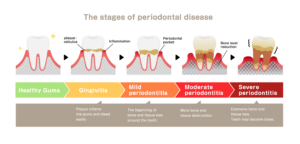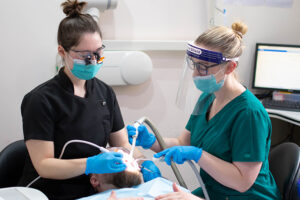 Gum disease is a prevalent oral health issue affecting millions of people worldwide. Two of the most common forms of gum disease are gingivitis and periodontal disease. While they are related, they differ in severity, causes, treatment, and long-term consequences. Understanding the type of gum disease you have is essential for effective treatment and long-term oral health. Whether it is gingivitis or periodontal disease, knowing the condition and its severity helps in making informed decisions about the treatment options and prevention.
Gum disease is a prevalent oral health issue affecting millions of people worldwide. Two of the most common forms of gum disease are gingivitis and periodontal disease. While they are related, they differ in severity, causes, treatment, and long-term consequences. Understanding the type of gum disease you have is essential for effective treatment and long-term oral health. Whether it is gingivitis or periodontal disease, knowing the condition and its severity helps in making informed decisions about the treatment options and prevention.
- Tailored Treatment Approach: Different types of gum disease require different levels of treatment depending on the stage and severity. Gingivitis can often be reversed with improved oral hygiene and professional cleanings, whereas periodontal disease may need more advanced interventions like deep cleaning, guided biofilm therapy, or even an onward referral to a specialist for surgery.
- Preventing Disease Progression: Recognising the early signs of gingivitis allows for timely intervention before it progresses to periodontitis, which is more serious and can lead to irreversible damage, including bone loss and ultimately loss of teeth from the mouth.
- Motivation for Better Oral Hygiene: Being aware of the condition and its implications will encourage you to take preventative action and be more likely to follow recommended oral hygiene practices, including brushing, flossing, and regular dental check-ups.

What is Gingivitis?
Gingivitis is the earliest and mildest form of gum disease. It is characterised by inflammation of the gums due to plaque buildup along the gumline. Plaque is a sticky film of bacteria that forms on teeth when oral hygiene is neglected.
Causes of Gingivitis:
- Poor oral hygiene
- Plaque and tartar buildup
- Hormonal changes (such as pregnancy or puberty)
- Smoking and tobacco use
- Certain medications
- Poor nutrition
- Chronic conditions like diabetes
Symptoms of Gingivitis:
- Red, swollen gums
- Bleeding gums, especially when brushing or flossing
- Bad breath (halitosis)
- Tenderness or mild discomfort
Treatment for Gingivitis:
The good news is that gingivitis is reversible with proper oral care and professional dental cleanings. Treatment includes:
- Regular brushing (twice daily) and flossing
- Professional hygiene visits (dental cleanings)
- Improved diet and lifestyle changes
What is Periodontal Disease?
If left untreated, gingivitis can progress to periodontal disease (periodontitis), a more severe and irreversible condition. Periodontal disease affects the gums, bone, and supporting structures of the teeth, leading to tooth loss if not managed properly.
Causes of Periodontal Disease:
- Untreated gingivitis
- Poor oral hygiene
- Smoking and tobacco use
- Genetic predisposition
- Systemic diseases (such as diabetes and heart disease)
- Stress (which weakens the immune system)
Symptoms of Periodontal Disease:
- Persistent bad breath
- Receding gums
- Formation of deep pockets between teeth and gums
- Loose or shifting teeth
- Pain when chewing
- Pus around the gums
How is Gum Disease Detected?
Early detection of gum disease is crucial for effective treatment. Your dentists or hygienist, use various methods to diagnose gum disease, including:
- Visual Examination: Checking for signs of gum inflammation, redness, swelling, and recession.
- Periodontal Probing: Measuring the depth of gum pockets using a specialised probe. Deeper pockets indicate more advanced disease.
- X-Rays: Identifying bone loss around the teeth, which is a key sign of periodontal disease.
- Plaque and Tartar Assessment: Evaluating the extent of bacterial buildup on the teeth and gums.
- Bleeding on Probing: If gums bleed easily during examination, it indicates inflammation and possible gum disease.
Treatment for Periodontal Disease
Unlike gingivitis, periodontal disease requires more intensive treatment, treatment options include:
- Deep Cleaning Procedures (Scaling and Root Planing): This involves removing plaque and tartar from below the gumline and smoothing the tooth roots to encourage gum reattachment.
- Antimicrobial Therapy: Special mouthwashes and locally applied antibiotics can help control bacterial infection.
- Guided Biofilm Therapy (GBT): A modern, minimally invasive approach that removes harmful biofilm using AirFlow technology, which involves a combination of warm water, air, and fine powder to gently clean deep pockets without damaging gum tissue.
- Surgical Treatments: In advanced cases, flap surgery or bone grafting may be necessary to restore damaged tissue and bone.
- Ongoing Periodontal Maintenance: Regular dental visits and professional cleanings help keep bacteria levels in check and prevent disease progression.
- Lifestyle Modifications: Quitting smoking, maintaining a healthy diet, and managing systemic conditions like diabetes can improve treatment outcomes.
Long-Term Consequences if Left Untreated
Neglecting gum disease can lead to serious health complications, including:
- Tooth loss due to bone deterioration
- Increased risk of heart disease and stroke
- Worsening diabetes symptoms
- Respiratory infections
- Potential pregnancy complications, including low birth weight and preterm birth
The Importance of Regular Hygiene Visits
Routine dental check-ups and cleanings are vital for preventing gum disease. Professional cleanings remove plaque and calculus buildup that cannot be removed by brushing and flossing alone. Regular visits also allow for early detection and treatment of gum issues before they become severe.

How to Improve Oral Hygiene at Home
Preventing and managing gum disease starts with your good oral care habits, including:
- Brushing teeth twice a day with fluoride toothpaste
- Flossing daily to remove plaque between teeth
- Using an antimicrobial mouthwash
- Maintaining a healthy diet low in sugar
- Avoiding tobacco products
Gingivitis and periodontal disease are serious oral health conditions that require attention and proper care. The good news is that with improved oral hygiene, regular dental visits, and lifestyle changes, gum disease can be prevented and managed effectively. Prioritising oral health not only ensures a beautiful smile but also contributes to overall well-being.
For professional advice and treatment, come and see us. Remember that regular dental check-ups are essential for catching gum disease early and keeping your oral health in check.